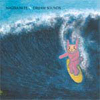NAGISA NI TE, "DREAM SOUNDS"
This odd release follows closely on the heels of Nagisa Ni Te's recent album The Same as a Flower.It's odd because it's a 40-minute album containing only four tracks,all of which are re-recorded versions of songs from their back catalog.It's hard to work out just what motivated Shinji Shibayama and MasakoTakeda to record this brief album, other than a desire to liberatethese songs from their previously relatively minimal instrumentalpalette and their low-fidelity recording style.
Jagjaguwar
It's no secret thatNagisa Ni Te have been inching ever closer to 1970s psych-rockterritory over the course of their last three albums, and this albumreflects this slow transition. At various times, the tracks on Dream Soundsevoke the Laurel Canyon sound, Neil Young and Pink Floyd: dreamy popsongs given a crisp rock sheen, with resounding electric guitar solos,multitracked choral backing and loads of spacious, canyonesque echo. Inthe midst of all this production sheen, however, the voices of Shinjiand his artistic muse Masako arrive untouched, with all their roughimperfections and flat intonations intact. Though the music clearlywears its Western rock influences on its sleeve, it's still peculiarlyJapanese, not least because the lyrics are sung in Nagisa Ni Te'snative tongue. The lyric translations provided in the sleeve notes byJapanophile Alan Cummings are almost extraneous, as one could easilyguess that the lyrics are full of light, breezy imagery about natureand romantic love. Three of the tracks are from the 1998 Japan-onlyrelease True World, with the track "The True Sun" extended intoan epic, sidelong exercise in folk-rock dynamics. Shinji mounts thisfinal track as a sequel to Neil Young's "Cortez the Killer," stretchingout its length with grandiloquent guitar soloing and soaring melodieson Fender Rhodes piano and various synthesizers, interrupted by quietacoustic passages. Five albums deep into their career, the onlycomplaint that could be leveled against Nagisa Ni Te is the deja vufamiliarity of many of their songs from album to album, which tend tosound more alike than different. This tendency is emphasized on thisalbum, which puts together several songs with similar sounding vocalmelodies. Since the majority of Western listeners won't understand thelyrics anyway, this places an emphasis on Nagisa Ni Te's arrangements,which do vary quite a bit and provide much of the richness and nuanceof the album. Even at their most rock n' roll, as on the track"Anxiety," there is still a light, insubstantial feel to a lot of thismusic which may ultimately prove the be the band's undoing. Theillustration of a cute pink Teletubby riding a wave on the album'scover doesn't help the problem, but with a track as epic andmagnificent as "The True Sun," Nagisa Ni Te prove that they still havequite a few pleasures in store.

Jagjaguwar
It's no secret thatNagisa Ni Te have been inching ever closer to 1970s psych-rockterritory over the course of their last three albums, and this albumreflects this slow transition. At various times, the tracks on Dream Soundsevoke the Laurel Canyon sound, Neil Young and Pink Floyd: dreamy popsongs given a crisp rock sheen, with resounding electric guitar solos,multitracked choral backing and loads of spacious, canyonesque echo. Inthe midst of all this production sheen, however, the voices of Shinjiand his artistic muse Masako arrive untouched, with all their roughimperfections and flat intonations intact. Though the music clearlywears its Western rock influences on its sleeve, it's still peculiarlyJapanese, not least because the lyrics are sung in Nagisa Ni Te'snative tongue. The lyric translations provided in the sleeve notes byJapanophile Alan Cummings are almost extraneous, as one could easilyguess that the lyrics are full of light, breezy imagery about natureand romantic love. Three of the tracks are from the 1998 Japan-onlyrelease True World, with the track "The True Sun" extended intoan epic, sidelong exercise in folk-rock dynamics. Shinji mounts thisfinal track as a sequel to Neil Young's "Cortez the Killer," stretchingout its length with grandiloquent guitar soloing and soaring melodieson Fender Rhodes piano and various synthesizers, interrupted by quietacoustic passages. Five albums deep into their career, the onlycomplaint that could be leveled against Nagisa Ni Te is the deja vufamiliarity of many of their songs from album to album, which tend tosound more alike than different. This tendency is emphasized on thisalbum, which puts together several songs with similar sounding vocalmelodies. Since the majority of Western listeners won't understand thelyrics anyway, this places an emphasis on Nagisa Ni Te's arrangements,which do vary quite a bit and provide much of the richness and nuanceof the album. Even at their most rock n' roll, as on the track"Anxiety," there is still a light, insubstantial feel to a lot of thismusic which may ultimately prove the be the band's undoing. Theillustration of a cute pink Teletubby riding a wave on the album'scover doesn't help the problem, but with a track as epic andmagnificent as "The True Sun," Nagisa Ni Te prove that they still havequite a few pleasures in store.
samples:



